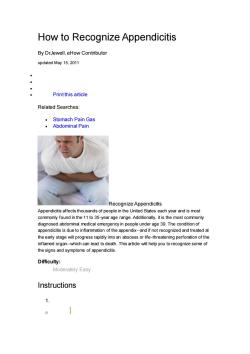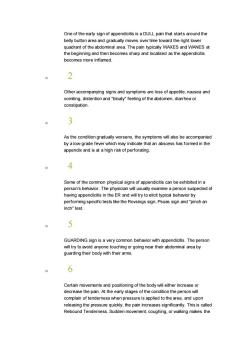《外科护理学》课程阅读资料(英文)How to Recognize Appendicitis

How to Recognize Appendicitis By DrJewell,eHow Contributor updated May 15.2011 Print this article Related Searches: Stomach Pain Gas Abdominal Pain Recognize Appendicitis Appendicitis affects thousands of people in the United States each year and is most commonly found in the 11 to 35-year age range.Additionally,it is the most commonly on of tdue tnof heendo diagnose cy in people under the early stage will progress rapidly into an abscess or life-threatening perforation of the inflamed organ--which can lead to death.This article will help you to recognize some of the signs and symptoms of appendicitis. Difficulty: Moderately Easy Instructions 1. 0
How to Recognize Appendicitis By DrJewell, eHow Contributor updated May 15, 2011 • • • • Print this article Related Searches: • Stomach Pain Gas • Abdominal Pain Recognize Appendicitis Appendicitis affects thousands of people in the United States each year and is most commonly found in the 11 to 35-year age range. Additionally, it is the most commonly diagnosed abdominal medical emergency in people under age 39. The condition of appendicitis is due to inflammation of the appendix--and if not recognized and treated at the early stage will progress rapidly into an abscess or life-threatening perforation of the inflamed organ--which can lead to death. This article will help you to recognize some of the signs and symptoms of appendicitis. Difficulty: Moderately Easy Instructions 1. o 1

One of the early sign of appendicitis is a DULL pain that starts around the belly button area and gradually moves over time toward the right lower quadrant of the abdominal area.The pain typically WA S and WANES at the beginning and then becomes sharp and localized as the appendicitis becomes more inflamed. 2 Other accompanying signs and symptoms are loss of appetite.nausea and vomiting.distention and"bloaty"feeling of the abdomen,diarrhea or constipation. 3 As the condition gradually worsens,the symptoms will also be accompanied by a low-grade fever which may indicate that an abscess has formed in the appendix and is at a high risk of perforating. 4 Some of the common physical signs of appendicitis can be exhibited in a person's behavior.The physician will usually examine a person suspected of having appendicitis in the ER and will try to elicit typical behavior by performing specific tests like the Rovsings sign,Psoas sign and"pinch an inch"test. 5 GUARDING sign is a very common behavior with appendicitis.The person will try to avoid anyone touching or going near their abdominal area by guarding their body with their arms. 6 Certain movements and positioning of the body will either increase or decrease the pain.At the early stages of the condition the person will complain of tenderness when pressure is applied to the area,and upon n increases significantly.This is called Rebound Tenderness.Sudden movement,coughing.or walking makes the
One of the early sign of appendicitis is a DULL pain that starts around the belly button area and gradually moves over time toward the right lower quadrant of the abdominal area. The pain typically WAXES and WANES at the beginning and then becomes sharp and localized as the appendicitis becomes more inflamed. o 2 Other accompanying signs and symptoms are loss of appetite, nausea and vomiting, distention and "bloaty" feeling of the abdomen, diarrhea or constipation. o 3 As the condition gradually worsens, the symptoms will also be accompanied by a low-grade fever which may indicate that an abscess has formed in the appendix and is at a high risk of perforating. o 4 Some of the common physical signs of appendicitis can be exhibited in a person's behavior. The physician will usually examine a person suspected of having appendicitis in the ER and will try to elicit typical behavior by performing specific tests like the Rovsings sign, Psoas sign and "pinch an inch" test. o 5 GUARDING sign is a very common behavior with appendicitis. The person will try to avoid anyone touching or going near their abdominal area by guarding their body with their arms. o 6 Certain movements and positioning of the body will either increase or decrease the pain. At the early stages of the condition the person will complain of tenderness when pressure is applied to the area, and upon releasing the pressure quickly, the pain increases significantly. This is called Rebound Tenderness. Sudden movement, coughing, or walking makes the

pain worse,but lying in a fetal position usually decreases the intensity of the pain. 7 Any time you suspect appendicitis you must seek medical attention because the key is to treat it before the organ ruptures or perforates.The inflamed organ is prone to rupture more quickly in a younger person than in an older person,so it is best to not take abdominal pain lightly,especially if you are younger
pain worse, but lying in a fetal position usually decreases the intensity of the pain. o 7 Any time you suspect appendicitis you must seek medical attention because the key is to treat it before the organ ruptures or perforates. The inflamed organ is prone to rupture more quickly in a younger person than in an older person, so it is best to not take abdominal pain lightly, especially if you are younger
按次数下载不扣除下载券;
注册用户24小时内重复下载只扣除一次;
顺序:VIP每日次数-->可用次数-->下载券;
- 《外科护理学》课程阅读资料(英文)How to Become a Surgical Nurse Practitioner.doc
- 《外科护理学》课程阅读资料(英文)Post-Operative Care of TURP.doc
- 《外科护理学》课程阅读资料(英文)Role of Nurses for Cardiac Surgery Patients.doc
- 山东第一医科大学(泰山医学院):《外科护理学》课程教学资源(试卷习题)试卷(二)答案(打印版).pdf
- 山东第一医科大学(泰山医学院):《外科护理学》课程教学资源(试卷习题)试卷(二)试题(打印版).pdf
- 山东第一医科大学(泰山医学院):《外科护理学》课程教学资源(试卷习题)试卷(一)答案(打印版).pdf
- 山东第一医科大学(泰山医学院):《外科护理学》课程教学资源(试卷习题)试卷(一)试题(打印版).pdf
- 山东第一医科大学(泰山医学院):《外科护理学》课程教学实验指导(负责人:张爱华,打印版).pdf
- 山东第一医科大学(泰山医学院):《外科护理学》课程教学资源(大纲)理论教学大纲(打印版).pdf
- 山东第一医科大学(泰山医学院):《外科护理学》课程教学资源(大纲)实验教学大纲(打印版).pdf
- 石河子大学:《实验诊断学》课程教学资源(PPT课件讲稿)血栓与止血(出血、血栓与止血检测).pptx
- 石河子大学:《实验诊断学》课程教学资源(PPT课件讲稿)尿液检查.ppt
- 石河子大学:《实验诊断学》课程教学资源(PPT课件讲稿)白细胞分类计数.ppt
- 石河子大学:《实验诊断学》课程教学资源(PPT课件讲稿)第三章 排泄物、分泌物及体液检验.ppt
- 石河子大学:《实验诊断学》课程教学资源(PPT课件讲稿)白细胞计数.ppt
- 石河子大学:《实验诊断学》课程教学资源(PPT课件讲稿)采血、血涂片的制备与染色.ppt
- 石河子大学:《实验诊断学》课程教学资源(PPT课件讲稿)常用肾脏功能实验室检测、肝脏病常用的实验室检查、临床常用生物化学检查、临床病原体检测.ppt
- 石河子大学:《实验诊断学》课程教学资源(PPT课件讲稿)Unit2 Basic Hematology.ppt
- 石河子大学:《实验诊断学》课程教学资源(PPT课件讲稿)Unit1 Intro to Laboratory Medicine.ppt
- 石河子大学:《实验诊断学》课程教学资源(PPT课件讲稿)第八章 临床常用免疫学检测(8.4-8.5)、第九章 临床病原体检测.ppt
- 《外科护理学》课程阅读资料(英文)Symptoms of Bowel Blockage.doc
- 《外科护理学》课程阅读资料(英文)How to Treat a Bowel Obstruction.doc
- 《外科护理学》课程阅读资料(英文)泌尿系统 urolithiasis.pdf
- 《外科护理学》课程阅读资料(英文)前列腺癌 prostate cancer.pdf
- 《外科护理学》课程阅读资料(英文)前列腺增生 prostatic hyperplasia.pdf
- 《外科护理学》课程阅读资料(英文)骨折 fracture.pdf
- 《外科护理学》课程阅读资料(英文)骨肿瘤 bone cancer.pdf
- 《外科护理学》课程阅读资料(英文)肺癌 lung cancer.pdf
- 《外科护理学》课程阅读资料(英文)周围血管疾病 venous thrombosis.pdf
- 《外科护理学》课程阅读资料(泌尿外科治疗指南)中国泌尿外科疾病诊断治疗指南的制定原则和方法-2010年.doc
- 《外科护理学》课程阅读资料(泌尿外科治疗指南)女性压力性尿失禁诊断治疗指南-2010年版.doc
- 《外科护理学》课程阅读资料(泌尿外科治疗指南)尿石症诊断治疗指南-2010年版.doc
- 《外科护理学》课程阅读资料(泌尿外科治疗指南)鹿角形肾结石评估2011年全文版.doc
- 《外科护理学》课程阅读资料(泌尿外科治疗指南)泌尿系感染诊断治疗指南-2011年全文版.doc
- 《外科护理学》课程阅读资料(泌尿外科治疗指南)泌尿系损伤诊断治疗指南-2011年全文版.docx
- 《外科护理学》课程阅读资料(泌尿外科治疗指南)肾上腺外科疾病诊断治疗指南_2011年全文版.doc
- 《外科护理学》课程阅读资料(泌尿外科治疗指南)泌尿男性生殖系畸形先天性疾病诊疗指南-2011年全文版.doc
- 《外科护理学》课程阅读资料(泌尿外科治疗指南)肾细胞癌诊治指南(2011年定稿).doc
- 《外科护理学》课程阅读资料(泌尿外科治疗指南)神经源性膀胱诊断治疗指南-2010年全文版.doc
- 《外科护理学》课程阅读资料(泌尿外科治疗指南)膀胱癌诊断治疗指南2011修订版.doc
